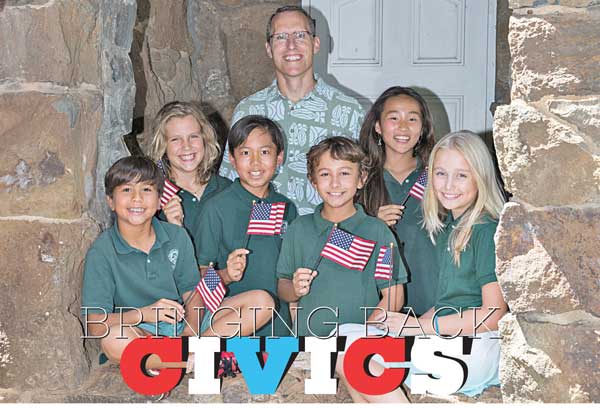Bringing Back Civics
By not having to “teach to the test,” educators have been able to create new, more inclusive ways of teaching,” adds Da Silva.
Gone are the strict lines separating subjects. Students now use science in art class, or math to diagram football plays in gym class.
“It’s a new way of challenging students,” he says. “There is a lot more critical thinking, different strategies they are using.”
Turnbull has seen the success of this sort of learning firsthand. He turned over his citizenship study guide to fifth-graders, who then were tasked to create a capstone project where they developed their own.
“I thought it would be a nice exercise if, rather than studying the thing, they were able participate in it,” says Turnbull. “We can read about citizenship and naturalization, but how often are you going to see somebody right next door go through the process?”
He says programs like Common Core and Strive HI are necessary in teaching today’s children.
“The interconnectivity of industry, economics and geopolitics, those three things together on top of an incredibly super-fast technical highway, means we have to teach the kids differently because they have to interconnect these things, and we also have to figure out how these kids will problemsolve for problems we didn’t have to worry about.”
How successful Strive HI and HCC have been is a matter of speculation, but the numbers are improving. According to the 2013 Superintendent’s Annual Report, reading proficiency has increased from 60 percent in 2007 to 72 percent in 2013. Math proficiency has climbed even more dramatically, from 39 to 60 percent during the same period.
“A good public education system is the fabric of a great community,” says Turnbull. “It doesn’t matter if I’m at Mid- Pacific or I’m at Roosevelt High School over the hill, what we do for kids is most important. It’s not about the label, the title on the door or the name of the school.”
To that end, Mid-Pac and other members of Hawaii Association of Independent Schools have partnered with their public-school counterparts to help spread the resources. Mid-Pac’s Kupu Hou Academy provides training for public school teachers to improve learning techniques. Punahou’s Pueo program provides advanced learning activities during the summer to students lacking financial resources.
“We view the private schools as our partners and they do the same,” says Da Silva. “Together we can rally our resources much more efficiently.”






